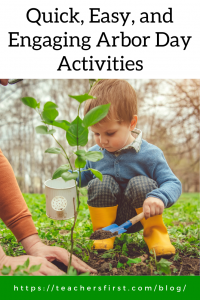“He who plants a tree plants hope.”
Lucy Larcom
This year commemorates the 150th anniversary of Arbor Day. J. Sterling Morton spearheaded the planting of one million trees in Nebraska in 1872, leading to the formation of the Arbor Day Foundation one hundred years later to carry on his mission. Over time, the foundation has distributed and planted over 500 million trees.
These no-tech/low tech and tech-infused ideas are sure to motivate students to share in the Arbor Day Foundation’s mission “to inspire people to plant, nurture, and celebrate trees. And our vision is to lead toward a world where trees are used to solve issues critical to survival by relentlessly delivering value.”
No Tech/Low Tech:
- Save a tree – can you go paperless for the day? Challenge yourself and your students to go through a day without using paper products. Don’t forget to consider paper towels, napkins, and other everyday items.
- Plant a tree – ask parents, parent/teacher associations, and community members to donate saplings or trees to plant in your schoolyard. If your school doesn’t have an area for trees, encourage students to offer to plant trees for neighbors or in nearby parks.
- Take a picture of a tree and identify the species. Can you guess how old it is? You can also identify trees by leaf types using the site, What Tree is It? (TeachersFirst review).
- Go outside and take pictures of your students hugging a tree, then ask students to write a poem or song for Arbor Day.
- Encourage students to become virtual junior park rangers sponsored by the National Park Service. Requirements are based upon the age of applicants and are available to students in any location.
- Have students decorate their desks and tables for Arbor Day using recycled materials. Create and award digital badges for students to save using Makebadges (TeachersFirst review).
- Ask students to create a design for an Arbor Day shirt to display in your classroom or hallway.
- Search Google for Earth Day songs and record yourself (alone or with a group) lip-synching the song. Even better, ask students to write and record songs they create.
Technology-Based:
- Take a virtual visit to view conservation efforts worldwide with Google Earth Voyager (TeachersFirst review). Open Voyager either on the link shared on the Google Earth link or directly within Google Earth using the icon that looks like a ship’s wheel. Scroll through to find and access images and interactive features that share information about the earth’s changing forests, visit Sequoia National Park, and more. If teaching younger students, explore the locations together or share with students before providing a link for studying independently. Demonstrate how to find and use the different features, including moving through the various images, changing views, and seeing the location on a globe.
- Ask older students to use Story Maps (TeachersFirst review) to create a virtual tour of native plants and trees found in your location. Using maps, students add images, audio, and text to create a visually appealing and interactive story. Share stories from Story Map’s gallery as examples for your students, including this story of a Journey Through the Tongass.
- Share the Seek app with students to use on mobile devices. Seek is a very easy-to-use app that uses your device’s camera to take pictures of wildlife and plants and identify them. In addition to identifying natural items, Seek also offers challenges for finding different species. One note of caution: sometimes Seek identifies items incorrectly. Use this as a learning experience. If there is an obvious mistake, have students share their knowledge to explain why it is wrong and what Seek might have used to misidentify the object.
- Learn about many different trees at National Geographic 101 (TeachersFirst review) if you can’t make it outside. Search for trees to read about trees worldwide as they relate to travel, environment, tourism, and photography.
- Design and share a GooseChase (TeachersFirst review) scavenger hunt using plants and animals around your school or locally. GooseChase offers options for creating scavenger hunts for teams that play in-person or remotely. Use the GooseChase Edu Game Library to find premade activities to use or adapt to your Arbor Day hunt.
- Genial.ly (TeachersFirst review) is a fantastic tool for creating many types of interactive content. Ask students to use one of Genial.ly’s tools, including presentations, infographics, and interactive images, to share information about Arbor Day or the conservation of trees.
Participating in Arbor Day celebrations offers the opportunity to consider the importance of trees to our ecosystems and communities. On the 150th anniversary of Arbor Day, it is critical to stop and think about the importance of trees to our students’ future well-being.
Do you celebrate Arbor Day and have engaging activities you use in your classroom? Please share them in the comments below.


